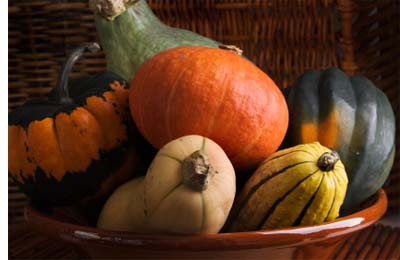Winter’s Plenty: Preparing and Storing Winter Squash
- By Heidi Lewis
- Last Updated On
- Reading Time: 2 mins.
By Heidi Lewis
The bounty of winter squash includes a fabulous array of colors, textures, and shapes. Just like the American population, they have an international palette of names, such as delicata, turban, Hubbard, Hokkaido, carnival, and butternut. Named for outstanding characteristics or in homage—for example, the turban squash mimics the shape of the familiar headdress, and the Hubbard is thought to be named after Elizabeth Hubbard, who purportedly distributed the seeds in the mid-19th century—there are 350 known varieties of squash, falling into two general camps of summer and winter.
The term “winter” squash is a cultural definition for hard-skinned squash that keep for months, as opposed to thin-skinned “summer” squash, such as zucchini or crookneck, that have to be eaten fresh. Winter squash is an essential category of produce that dates back to a time when our survival depended on what could be stored. Representing several species within gourd family genus Cucurbita, winter squash offers up a visually stunning cast of characters, from smooth-skinned orbs to some reminiscent of colorful Dale Chihuly sculptures.
One of the world’s oldest cultivated foods, evidence of squash consumption has been found in 10,000-year-old caves and dwellings of ancient Mesoamerica. From there, it spread to the rest of the world where each culture refined its own unique squash expressions. The bumpy, alligator-skinned Marina De Chioggia squash hails from Italy, the Cinderella coach–looking Musquée de Provence comes from France, and the chestnut-flavored Red Kuri and Kabocha are from Japan. The hard shells of winter squash and gourds have been used as scoops, bowls, and even musical instruments.
Get tips for your office
Be an office hero!
Preparation
The skin of most winter squash is hard to peel: use a sharp knife to carefully cut it in halves or quarters, scoop out the seeds (which can also be washed and roasted), and roast, steam, or sauté until soft. Squash can be used in soups, salads, sautés, fritters, purees, and, of course, in pies.
Storage
Keep squash where it can be admired for its beauty. Store at room temperature out of direct sunlight, and don’t let it get moist. Use within 2–3 weeks.
Get tips for your office
Be an office hero!
Recent Articles
Corporate Wellness Program Planning: Your 2026 Guide to a Healthier Workplace
How to Extinguish Burnout with Perks, Benefits, and Smart Leadership
Employee Engagement Solutions for Hybrid Teams: 4 Ideas to Try
Remembering Frieda Caplan, Queen of the Kiwi
Donate-a-Crate Makes Corporate Giving Easy and Tasty
Subscribe to our Newsletter
"*" indicates required fields



